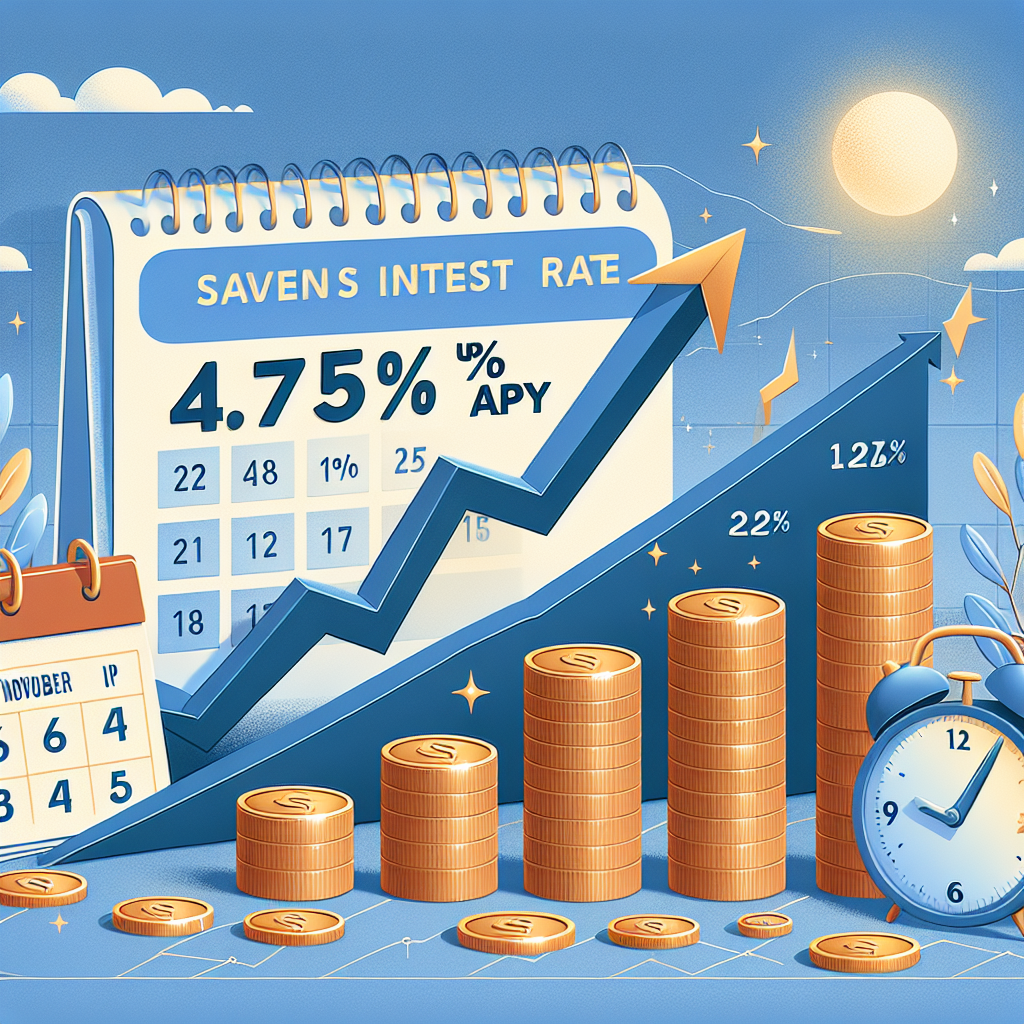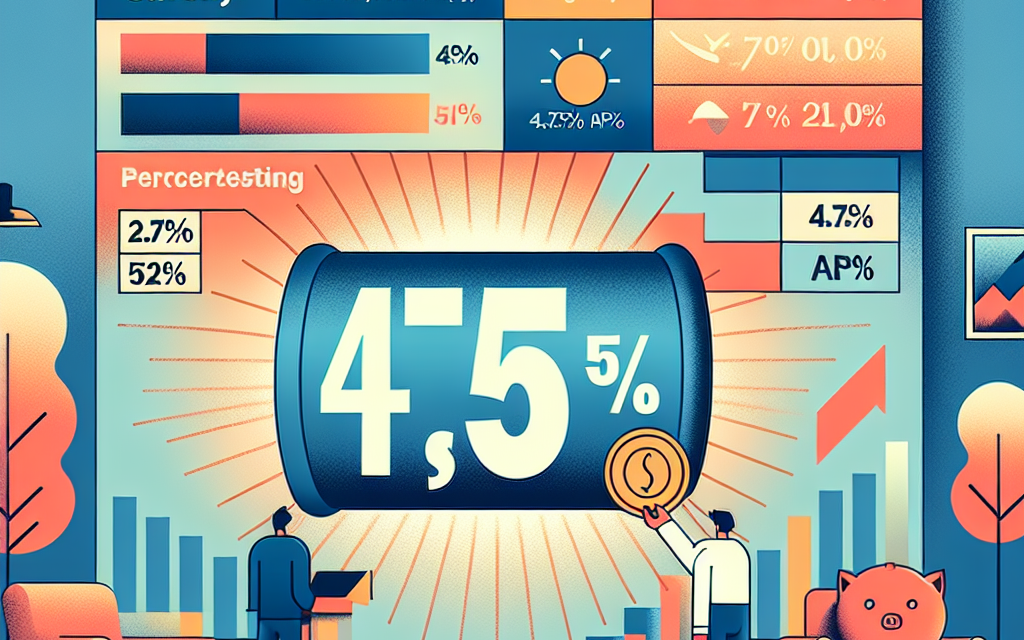“Maximize Your Savings: Earn Up to 4.75% APY Today!”
Introduction
As of November 15, 2024, savers are witnessing a favorable shift in the landscape of savings interest rates, with opportunities to earn up to 4.75% Annual Percentage Yield (APY) on their deposits. This development comes as financial institutions respond to broader economic trends and monetary policy adjustments, offering competitive rates to attract depositors. The increase in savings interest rates presents an advantageous scenario for individuals looking to maximize their returns on savings accounts, money market accounts, and certificates of deposit. As consumers navigate these options, understanding the factors influencing these rates and the potential benefits of higher yields becomes essential for effective financial planning and growth.
Understanding the Factors Influencing Current Savings Interest Rates
As of November 15, 2024, savers are witnessing a notable shift in the landscape of savings interest rates, with some financial institutions offering rates as high as 4.75% Annual Percentage Yield (APY). This development is particularly significant for individuals looking to maximize their savings returns. To fully understand the factors influencing these current savings interest rates, it is essential to consider a variety of economic and financial elements that play a crucial role in shaping the interest rate environment.
Firstly, the broader economic climate is a primary determinant of savings interest rates. Central banks, such as the Federal Reserve in the United States, set benchmark interest rates that influence the rates offered by banks and credit unions. In recent years, central banks have adjusted these rates in response to inflationary pressures and economic growth indicators. For instance, in an effort to curb inflation, central banks may increase benchmark rates, which in turn can lead to higher savings interest rates as financial institutions adjust to the new cost of borrowing.
Moreover, inflation itself is a critical factor. When inflation rates rise, the purchasing power of money decreases, prompting savers to seek higher returns to maintain their wealth. Consequently, banks may offer more attractive savings rates to attract deposits, which they can then use to fund loans at higher interest rates. This dynamic creates a competitive environment where financial institutions vie for consumer deposits by offering more appealing rates.
In addition to macroeconomic factors, the competitive landscape among financial institutions also plays a significant role. With the advent of online banks and fintech companies, traditional banks face increased competition. These newer entities often have lower overhead costs and can pass these savings on to consumers in the form of higher interest rates. As a result, traditional banks may be compelled to raise their rates to remain competitive and retain their customer base.
Furthermore, the overall health of the banking sector can influence savings interest rates. In times of financial stability, banks may be more willing to offer higher rates as they have greater confidence in their ability to manage risks. Conversely, during periods of financial uncertainty, banks might lower rates to preserve capital and maintain liquidity.
Another important consideration is the regulatory environment. Changes in banking regulations can impact how banks manage their reserves and capital, which in turn affects the rates they offer to savers. For example, more stringent capital requirements might lead banks to offer lower rates as they prioritize maintaining adequate reserves.
Lastly, consumer behavior and expectations cannot be overlooked. As consumers become more financially literate and aware of their options, they are more likely to shop around for the best rates. This increased awareness puts pressure on financial institutions to offer competitive rates to attract and retain customers.
In conclusion, the current savings interest rates, which can reach up to 4.75% APY, are the result of a complex interplay of economic conditions, competitive pressures, regulatory changes, and consumer behavior. Understanding these factors provides valuable insight into why rates are at their current levels and how they might evolve in the future. As savers navigate this landscape, staying informed about these influences can help them make more strategic decisions about where to place their savings for optimal returns.
Comparing Savings Accounts: Finding the Best Rates in 2024
As of November 15, 2024, the landscape of savings accounts has evolved significantly, offering consumers a variety of options to maximize their savings with competitive interest rates. In an era where financial prudence is paramount, understanding the nuances of these accounts is essential for making informed decisions. The current savings interest rates, which can reach up to 4.75% Annual Percentage Yield (APY), present an attractive opportunity for savers seeking to grow their funds securely.
To begin with, the rise in interest rates can be attributed to several economic factors, including central bank policies aimed at curbing inflation and stabilizing the economy. As a result, financial institutions have adjusted their offerings to remain competitive, providing savers with more lucrative options. This shift has prompted many individuals to reevaluate their current savings strategies, considering the potential benefits of switching to accounts with higher yields.
When comparing savings accounts, it is crucial to consider not only the APY but also the terms and conditions associated with each account. For instance, some accounts may offer high introductory rates that revert to lower rates after a specified period. Therefore, it is advisable to scrutinize the fine print to ensure that the attractive rates are sustainable in the long term. Additionally, minimum balance requirements and fees can significantly impact the overall returns on savings, making it essential to choose an account that aligns with one’s financial habits and goals.
Moreover, the digital transformation of banking services has introduced a new dimension to savings account offerings. Online banks, in particular, have emerged as formidable contenders in the market, often providing higher interest rates than their traditional counterparts. This is largely due to their lower overhead costs, which allow them to pass on the savings to their customers in the form of better rates. Consequently, consumers are increasingly drawn to these digital platforms, appreciating the convenience and enhanced returns they offer.
In addition to online banks, credit unions have also become popular choices for savers seeking competitive rates. These member-owned institutions typically offer favorable terms and personalized service, making them an attractive alternative to conventional banks. By pooling resources and focusing on community-oriented values, credit unions can often provide higher interest rates and lower fees, further enhancing their appeal.
As savers navigate the myriad of options available, it is important to consider the broader economic context and potential future changes in interest rates. While current rates are enticing, they are subject to fluctuations based on economic conditions and monetary policy decisions. Therefore, maintaining a diversified savings strategy that includes a mix of high-yield savings accounts, certificates of deposit, and other investment vehicles can help mitigate risks and optimize returns.
In conclusion, the current savings interest rates of up to 4.75% APY present a compelling opportunity for individuals to enhance their financial well-being. By carefully comparing the various offerings and considering factors such as account terms, digital banking options, and credit union benefits, savers can make informed decisions that align with their financial objectives. As the economic landscape continues to evolve, staying informed and adaptable will be key to maximizing the potential of one’s savings in 2024 and beyond.
How to Maximize Your Savings with a 4.75% APY
As of November 15, 2024, the financial landscape for savers has become increasingly favorable, with some institutions offering savings interest rates as high as 4.75% Annual Percentage Yield (APY). This development presents a significant opportunity for individuals looking to maximize their savings. To take full advantage of these elevated rates, it is essential to understand the factors contributing to these changes and the strategies that can be employed to optimize savings.
The rise in savings interest rates can be attributed to several economic factors, including adjustments in monetary policy and shifts in market dynamics. Central banks have been gradually increasing interest rates to combat inflationary pressures, which in turn has led to higher yields on savings accounts. This environment is particularly beneficial for savers who have endured years of relatively low returns on their deposits. Consequently, it is crucial for individuals to reassess their current savings strategies and consider transitioning to accounts that offer more competitive rates.
To maximize the benefits of a 4.75% APY, it is advisable to first conduct thorough research to identify financial institutions that offer these rates. Online banks and credit unions often provide higher interest rates compared to traditional brick-and-mortar banks due to their lower overhead costs. Therefore, exploring these options can be a prudent step. Additionally, it is important to review the terms and conditions associated with these accounts, as some may require a minimum balance or impose certain restrictions on withdrawals.
Once a suitable account is identified, diversifying savings across multiple accounts can further enhance returns. By spreading funds across different institutions, savers can take advantage of varying interest rates and terms, thereby reducing risk and increasing potential earnings. Moreover, this approach can provide greater flexibility in managing funds, as it allows for easier access to cash when needed without incurring penalties.
Another effective strategy is to automate savings contributions. Setting up automatic transfers from a checking account to a high-yield savings account ensures consistent growth of savings over time. This method not only simplifies the savings process but also instills a disciplined approach to financial management. By regularly contributing to a savings account, individuals can benefit from the power of compound interest, which significantly boosts the overall return on investment.
Furthermore, it is essential to periodically review and adjust savings strategies in response to changing economic conditions. Interest rates can fluctuate based on various factors, and staying informed about these changes can help savers make timely decisions to optimize their returns. Engaging with financial advisors or utilizing online financial tools can provide valuable insights and guidance in navigating the evolving financial landscape.
In conclusion, the current savings interest rates of up to 4.75% APY present a promising opportunity for individuals to enhance their financial well-being. By conducting thorough research, diversifying savings, automating contributions, and staying informed about economic trends, savers can effectively maximize their returns. As the financial environment continues to evolve, adopting these strategies will not only help in achieving short-term financial goals but also contribute to long-term financial security.
The Impact of Economic Trends on Savings Interest Rates

As of November 15, 2024, savers are witnessing a notable shift in the landscape of savings interest rates, with some financial institutions offering rates as high as 4.75% Annual Percentage Yield (APY). This development is largely influenced by prevailing economic trends, which have played a significant role in shaping the current financial environment. Understanding these trends is crucial for individuals seeking to maximize their savings returns.
To begin with, the recent adjustments in savings interest rates can be attributed to the broader economic context, particularly the monetary policies implemented by central banks. Over the past year, central banks have been actively managing interest rates to combat inflationary pressures. As inflation rates surged, central banks responded by increasing benchmark interest rates, a move that has had a cascading effect on savings accounts. Consequently, financial institutions have adjusted their savings rates upwards to remain competitive and attract depositors.
Moreover, the global economic recovery following the disruptions caused by the COVID-19 pandemic has also contributed to the current interest rate environment. As economies rebound, consumer spending and business investments have increased, leading to a higher demand for credit. This demand has prompted banks to offer more attractive savings rates to secure the necessary capital for lending purposes. In this context, savers are benefiting from the competitive dynamics within the banking sector, as institutions vie for deposits by offering higher returns.
In addition to these factors, technological advancements and the rise of digital banking have further influenced savings interest rates. Online banks and fintech companies, unburdened by the overhead costs associated with traditional brick-and-mortar institutions, are able to offer more competitive rates. These digital platforms have gained popularity among consumers seeking higher yields on their savings, thereby pressuring traditional banks to adjust their rates accordingly. As a result, the increased competition in the financial sector has led to more favorable conditions for savers.
Furthermore, geopolitical events and their impact on global markets cannot be overlooked when examining the current savings interest rate trends. Uncertainties in international trade, political tensions, and shifts in global economic power dynamics have all contributed to market volatility. In response, investors have sought safe havens for their assets, leading to an influx of deposits in savings accounts. This increased demand for secure savings options has incentivized banks to offer higher interest rates to attract and retain customers.
While these economic trends have created opportunities for savers to earn higher returns, it is important to consider the potential risks associated with fluctuating interest rates. Savers should remain vigilant and informed about the broader economic environment, as changes in monetary policy or unexpected economic developments could impact future interest rates. Diversifying savings across different financial products and institutions can help mitigate these risks and ensure a balanced approach to personal finance.
In conclusion, the current savings interest rates, reaching up to 4.75% APY, are a reflection of various economic trends, including central bank policies, global economic recovery, technological advancements, and geopolitical factors. These elements have collectively shaped a favorable environment for savers, offering them an opportunity to enhance their financial returns. By staying informed and strategically managing their savings, individuals can effectively navigate the evolving financial landscape and make the most of the current interest rate climate.
Tips for Choosing the Right Savings Account for Your Needs
As of November 15, 2024, the landscape of savings interest rates has become increasingly favorable for consumers, with some financial institutions offering rates as high as 4.75% APY. This development presents an opportune moment for individuals to reassess their savings strategies and choose accounts that best align with their financial goals. However, selecting the right savings account involves more than just opting for the highest interest rate. It requires a comprehensive evaluation of various factors to ensure that the account meets your specific needs.
To begin with, it is essential to consider the accessibility of funds. While high-yield savings accounts offer attractive interest rates, they may come with restrictions on withdrawals or require a minimum balance to maintain the advertised rate. Therefore, it is crucial to assess your liquidity needs and determine how often you anticipate accessing your savings. If you require frequent access to your funds, a traditional savings account with fewer restrictions might be more suitable, even if it offers a slightly lower interest rate.
In addition to accessibility, fees associated with savings accounts can significantly impact your overall returns. Many high-yield accounts boast competitive rates but may also impose monthly maintenance fees, transaction fees, or penalties for falling below a minimum balance. These fees can erode the benefits of a higher interest rate, so it is important to carefully review the fee structure of any account you are considering. Opting for an account with minimal or no fees can enhance your savings potential over time.
Furthermore, the reputation and stability of the financial institution should not be overlooked. While online banks and credit unions often provide higher interest rates than traditional banks, it is vital to ensure that the institution is reputable and financially sound. Researching the bank’s history, customer reviews, and financial health can provide valuable insights into its reliability. Additionally, confirming that the institution is insured by the Federal Deposit Insurance Corporation (FDIC) or the National Credit Union Administration (NCUA) will protect your deposits up to the insured limit.
Moreover, the convenience of managing your savings account is another factor to consider. In today’s digital age, the ability to manage your account online or through a mobile app can greatly enhance your banking experience. Features such as mobile check deposit, automatic transfers, and real-time balance updates can simplify account management and help you stay on top of your savings goals. Therefore, evaluating the digital tools and customer service options offered by the bank can be a determining factor in your decision-making process.
Finally, it is important to align your choice of savings account with your long-term financial objectives. If you are saving for a specific goal, such as a down payment on a house or an emergency fund, consider how the account’s terms and conditions will support your timeline and savings target. Some accounts may offer tiered interest rates that increase with higher balances, which can be advantageous if you plan to grow your savings over time.
In conclusion, while the prospect of earning up to 4.75% APY on a savings account is enticing, it is imperative to conduct a thorough evaluation of your personal financial needs and the features of available accounts. By considering factors such as accessibility, fees, institutional reputation, convenience, and alignment with your financial goals, you can make an informed decision that maximizes the benefits of your savings strategy.
The Role of Online Banks in Offering Competitive Savings Rates
As of November 15, 2024, the financial landscape for savers has become increasingly favorable, with interest rates on savings accounts reaching up to 4.75% Annual Percentage Yield (APY). This development is largely attributed to the growing influence of online banks, which have emerged as key players in offering competitive savings rates. The rise of online banking institutions has transformed the traditional banking sector, providing consumers with more lucrative options for growing their savings. This shift is particularly significant in an era where maximizing returns on savings is a priority for many individuals.
Online banks have been able to offer higher interest rates primarily due to their lower operational costs. Unlike traditional brick-and-mortar banks, online banks do not incur expenses related to physical branches, such as rent, utilities, and in-person staffing. This cost efficiency allows them to pass on the savings to their customers in the form of higher interest rates. Consequently, consumers are increasingly drawn to these digital platforms, seeking to capitalize on the more attractive returns they offer. Moreover, the convenience of managing finances online, coupled with the competitive rates, has made online banks a preferred choice for tech-savvy individuals and those looking to optimize their savings.
In addition to cost savings, online banks have leveraged technology to enhance customer experience and streamline banking operations. Advanced digital platforms enable seamless account management, providing users with easy access to their funds and real-time updates on their account status. This technological edge not only attracts customers but also fosters trust and reliability, which are crucial in the financial sector. Furthermore, online banks often offer user-friendly mobile applications, allowing customers to manage their accounts on the go. This level of accessibility and convenience is a significant factor in the growing popularity of online banks.
The competitive landscape has also prompted traditional banks to reevaluate their offerings. In response to the attractive rates provided by online banks, some traditional banks have begun to increase their own savings rates to retain customers. However, the challenge remains for these institutions to match the efficiency and cost-effectiveness of their online counterparts. As a result, many traditional banks are investing in digital transformation initiatives to enhance their online presence and offer more competitive products. This trend underscores the broader shift towards digital banking solutions and the increasing importance of technology in the financial services industry.
While the rise of online banks presents numerous benefits for consumers, it is essential for individuals to conduct thorough research before selecting a banking institution. Factors such as the bank’s reputation, customer service quality, and security measures should be carefully considered. Additionally, understanding the terms and conditions associated with high-yield savings accounts is crucial to ensure that the benefits align with one’s financial goals. By making informed decisions, consumers can effectively leverage the competitive rates offered by online banks to maximize their savings potential.
In conclusion, the current savings interest rates, reaching up to 4.75% APY, highlight the significant role online banks play in offering competitive financial products. Their ability to provide higher returns, coupled with technological advancements, has reshaped the banking landscape, prompting both consumers and traditional banks to adapt to this evolving environment. As the financial sector continues to embrace digital innovation, the influence of online banks is likely to grow, offering consumers even more opportunities to enhance their savings strategies.
Future Predictions: Will Savings Interest Rates Continue to Rise?
As of November 15, 2024, savers are witnessing a notable shift in the landscape of savings interest rates, with some financial institutions offering rates as high as 4.75% Annual Percentage Yield (APY). This development marks a significant change from the historically low rates that have characterized the past decade. The question on many savers’ minds is whether this upward trend in interest rates will continue, or if it is merely a temporary adjustment. To understand the potential trajectory of savings interest rates, it is essential to consider several economic factors and market dynamics that influence these rates.
Firstly, the role of central banks, particularly the Federal Reserve in the United States, cannot be overstated. The Federal Reserve’s monetary policy decisions, including adjustments to the federal funds rate, have a direct impact on savings interest rates. In recent years, the Federal Reserve has adopted a more hawkish stance in response to rising inflationary pressures, leading to a series of interest rate hikes. This has, in turn, prompted banks and credit unions to increase the interest rates offered on savings accounts to remain competitive and attract deposits. If inflation continues to be a concern, it is likely that the Federal Reserve will maintain or even increase interest rates, which could sustain or further elevate savings interest rates.
Moreover, the broader economic environment plays a crucial role in shaping interest rate trends. Economic growth, employment levels, and consumer spending all influence the demand for credit and savings. In a robust economy, where employment is high and consumer confidence is strong, individuals are more likely to save, providing banks with the capital needed to offer higher interest rates. Conversely, in a sluggish economy, savings rates may stagnate or decline as financial institutions face reduced demand for loans and increased competition for deposits. Therefore, monitoring economic indicators such as GDP growth and unemployment rates can provide valuable insights into the future direction of savings interest rates.
Additionally, technological advancements and the rise of digital banking have introduced new dynamics into the savings market. Online banks and fintech companies, unburdened by the overhead costs associated with traditional brick-and-mortar institutions, often offer higher interest rates to attract tech-savvy consumers. This competition has pressured traditional banks to reevaluate their interest rate offerings to retain customers. As technology continues to evolve, it is plausible that digital platforms will play an increasingly significant role in shaping savings interest rates, potentially driving them higher as competition intensifies.
Furthermore, global economic conditions and geopolitical events can also influence domestic interest rates. For instance, international trade tensions, currency fluctuations, and political instability can create uncertainty in financial markets, prompting central banks to adjust their monetary policies accordingly. Such adjustments can have a ripple effect on savings interest rates, either bolstering or dampening them depending on the nature of the global economic climate.
In conclusion, while the current savings interest rates of up to 4.75% APY are encouraging for savers, predicting their future trajectory requires a comprehensive analysis of various economic and market factors. Central bank policies, economic growth, technological advancements, and global events all play interconnected roles in determining the direction of interest rates. As these elements continue to evolve, savers should remain informed and adaptable, ready to seize opportunities as they arise in this dynamic financial landscape.
Q&A
1. **What is the highest APY available for savings accounts as of November 15, 2024?**
The highest APY available is 4.75%.
2. **Are there any banks offering 4.75% APY on savings accounts?**
Yes, some banks are offering up to 4.75% APY.
3. **What factors should be considered when choosing a savings account with a high APY?**
Consider factors such as minimum balance requirements, fees, withdrawal limits, and the bank’s reputation.
4. **How does the current highest APY compare to historical rates?**
The current highest APY of 4.75% is relatively high compared to historical rates over the past decade.
5. **What is the average APY for savings accounts as of November 2024?**
The average APY for savings accounts is around 3.5%.
6. **Are online banks offering higher APYs than traditional banks?**
Yes, online banks often offer higher APYs than traditional banks due to lower overhead costs.
7. **What impact do Federal Reserve interest rate changes have on savings account APYs?**
Changes in Federal Reserve interest rates can influence banks to adjust their savings account APYs, often leading to increases or decreases in line with rate changes.
Conclusion
As of November 15, 2024, savings interest rates have reached a notable level, with some financial institutions offering up to 4.75% Annual Percentage Yield (APY). This increase in rates reflects broader economic conditions, including monetary policy adjustments aimed at controlling inflation and stimulating savings. The competitive rates provide an attractive opportunity for savers to enhance their returns compared to previous years when rates were significantly lower. However, individuals should carefully assess the terms and conditions associated with these accounts, as well as consider the impact of inflation on real returns. Overall, the elevated savings interest rates present a favorable environment for savers looking to maximize their earnings on deposits.





